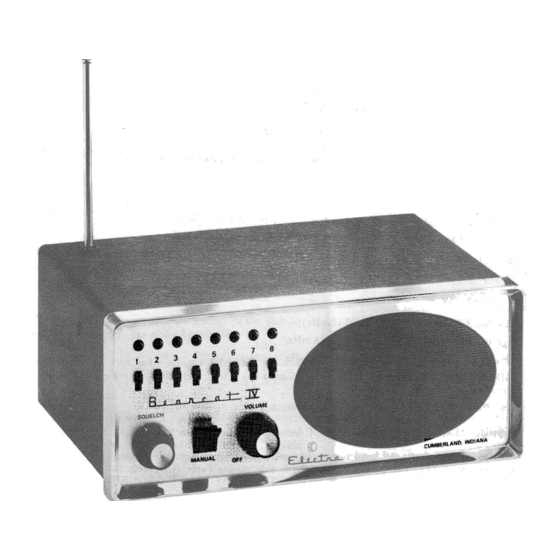Electra bearcat IV 사용 설명서 - 페이지 4
{카테고리_이름} Electra bearcat IV에 대한 사용 설명서을 온라인으로 검색하거나 PDF를 다운로드하세요. Electra bearcat IV 12 페이지. Fm monitor receiver

CRYSTAT INSTALLATION
DISCONNECT POWER BEFORE REMOVING CABINET
L E A V E P O W E R O F F W H I L E I N S T A L L I N G C R Y S T A L S
To remove the cabinet, first remove the screw at the bot-
tom rear edge. Push the rear panel forward through the cab-
inet. The components and crystal sockets are in full view and
easily accessible.
Up to eight crystals may be installed in any combination
of L, H, or U/T bands. Each crystal is installed in the sockets
corresponding to its channel. (Channel I is nearest the side of
the radio)
The eight three-position slide switches select the desired
band for each crystal. To select "Lo"
Band (30-50mHz) for
a particular channel, place the corresponding switch in the
"L"
position. (Nearest the front of the radio). The center or
"H"
position of the switch selects
"Hi"
Band (150-l74mHz) and
the third or
o'U/T"
position is used for both
"U"
(450-470
mHz) andooT" (470-5l2mHz) bands.
Remove the crystal by a gentle pull upward. Insert the cry-
stal by aligning the pins with the sockets and pushing straight
down. DO NOT BEND THE SOCKETS. THESE \'IINIA-
TURE SOCKETS ARE N,IADE OF SPRING BRONZE AND
WILL BREAK OFF IF BENT EXCESSIVELY.
NOTE: Do not install two crystals of the same frequency.
Rigid qualiry' standards are applied to crystals furnished
by Electra Company to assure full performance. therefore our
warranty does not include correcting poor operation caused by
crystals from other sources.
The "U/T" alignment spread is 450mHz to ll2mH.z, the
"H" 150mHz to
l7[mHz, and the "L" 33m[z to ABmHz.
New frequencies may be added within these spreads.
CRYSTAL FORMULAS
'(L'r
Received frequency + 10.80 mHz = crystal frequency
Example:
35.80 mHz + f0.80 mHz = 46.600fi)
mHz
"H"
-
Received frequency -
10.80 mHz = crystal frequency
3
Example: 155.01 mHz - 10.80 mHz = 48.07000
3
,, UIT"
Received frequency -
10.80 mHz = cr1 stal frequency
I
Example: 453.250 mHz - 10.80 mHz = {9.16llI mHz
9
USER HINTS
Radio equipment usually operates in an environment of
man-made electro-magnetic noise which radiates from power
lines, fluorescent lights, motors, appliances, ignition systems,
etc. Modern radios are designed to minimize interference from
such sources but operation may be affected under conditions
of unusually strong noise.
Distant weak,
".hp"
or noise signals may be received by
this receiver because of its high sensitiuity. Whenever such
conditions interrupt scanning or whenever a very busy channel
prevents reception of other desired signals, the affected
channel may be bypassed by means of its individual panel
switch.
ln cases of strong interfering noise or signals it may be
desirable to reduce the length of the antenna to reduce noise
pickup below a critical level. This may be very effective in
medium and strong signal areas.
-Single-channel operation may be obtained as described
under Operating Instructions. It may also be accomplished
with the "\IANUAL-SCAN" switch in either position by lock-
ing out all but the desired channel. This assures that the radio
will alwavs be on that channel even when turned OFF and ON.
Continuous-carrier signals such as the ESSA weather broad-
casls on 162.55mH2, which are available in many areas, may
be received when desired by use of the individual channel
swi tches.
In mobile service the commonly encountered poor recep-
tion conditions are signal fading, nearhy faulty ignition
systems, power lines and proximity to strong signals. Careful
setting of the squelch control will minimize these conditions.
Shen moring or shipping the radio, remove the telescoping
antenna to avoid damage to it or to the internal circuit assem-
blies.
R A D I O S E R V I C E S
Locd Govemment
Specid Emergency
Police
Highway Maintenance
-Hospitds
Fire
Forestry-Conserration
-Ambulances
Press
Motion Pictures
-Physicians
Business
Special Indusbial
-Disaster Relief
Railroad
Telephone Maintenance
-School Busses
Taxicab
Automotile
Emergency
Power
Marine
Public Mobile Radio
Peholeum
Manufachrers
Mobile Telephones
Forest Products
Motor Carrier
Rural Radio
00 0000 00
t 2 3 . 1 5 8 7 8
[ i l [ [ [ [ 0 0
- 4 -
